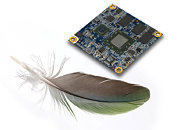Tuesday, December 1st 2009

VIA Mobile-ITX Brings Further Miniaturization and Greater Flexibility to Devices
VIA Technologies, Inc, a leading innovator of power efficient x86 processor platforms, today announced Mobile-ITX, the latest VIA-developed open form factor specification for the creation of ultra-compact and portable embedded devices. Mobile-ITX defines a uniquely compact 6cm x 6cm computer-on-module specification designed to enable an easier and less resource intensive development cycle for a range of ultra-compact, portable embedded systems.
Vertical market segments including medical, transportation and military embedded markets have evolved to demand greater miniaturization and portability from today's x86 platforms. Mobile-ITX addresses the need for a simple, modular approach to portable IPC design, making it easier than ever to bring to market ultra-compact and lightweight devices that offer comprehensive connectivity options and a rich, flexible feature set."With Mobile-ITX we have again pushed back the barriers that limit just how small an embedded industrial PC can be," said Daniel Wu, Vice President, VIA Embedded Platform Division, VIA Technologies, Inc. "Mobile-ITX enables the creation of a new breed of ultra-compact, portable networked devices suitable for a range of applications, particularly in modern medical and military segments."
Mobile-ITX - The Science of Small
Extending VIA's reputation as a leading innovator and creator of ultra-compact form factors, Mobile-ITX at 6cm x 6cm, is currently the most compact computer-on-module form factor on the market, an incredible 50% smaller than the successful VIA-developed Pico-ITX form factor.
Mobile-ITX employs a modularized design that includes a CPU module card and an I/O carrier board. This offers greater flexibility for developers who can simply drop in the CPU module to a custom designed, application specific carrier board, negating lengthy developmental design and testing phases.
CPU modules based on the Mobile-ITX form factor integrate core CPU, chipset and memory functionality and I/O that includes the CRT, DVP and TTL display support, HD Audio, IDE, USB 2.0, as well as PCI Express, SMBus, GPIO, LPC, SDIO and PS2 signals, through customizable baseboards. In keeping with VIA's signature low power philosophy, Mobile-ITX-based modules consume as little as 5 watts, ideal for always-on, mission critical systems.
This comprehensive range of advanced technologies can be implemented on a variety of Mobile-ITX compatible carrier board designs that can be adapted to suit almost any environment, or application specific criteria. The CPU module I/O signals are mapped to two unique high density, low profile connectors on the under side of the module, with a distance between the CPU module and the baseboard of only 3mm, making it ideal for ultra-slim system designs. The connectors can also withstand vibrations of up to 5Gs making Mobile-ITX systems suitable for in-vehicle and industrial machining applications.
More details about the Mobile-ITX form factor may be found at the VIA website where you can also find a detailed "Mobile-ITX Form Factor" whitepaper.
The VIA Embedded Platform Division will announce the first commercial CPU module based on the Mobile-ITX form factor in Q1 2010.
Vertical market segments including medical, transportation and military embedded markets have evolved to demand greater miniaturization and portability from today's x86 platforms. Mobile-ITX addresses the need for a simple, modular approach to portable IPC design, making it easier than ever to bring to market ultra-compact and lightweight devices that offer comprehensive connectivity options and a rich, flexible feature set."With Mobile-ITX we have again pushed back the barriers that limit just how small an embedded industrial PC can be," said Daniel Wu, Vice President, VIA Embedded Platform Division, VIA Technologies, Inc. "Mobile-ITX enables the creation of a new breed of ultra-compact, portable networked devices suitable for a range of applications, particularly in modern medical and military segments."
Mobile-ITX - The Science of Small
Extending VIA's reputation as a leading innovator and creator of ultra-compact form factors, Mobile-ITX at 6cm x 6cm, is currently the most compact computer-on-module form factor on the market, an incredible 50% smaller than the successful VIA-developed Pico-ITX form factor.
Mobile-ITX employs a modularized design that includes a CPU module card and an I/O carrier board. This offers greater flexibility for developers who can simply drop in the CPU module to a custom designed, application specific carrier board, negating lengthy developmental design and testing phases.
CPU modules based on the Mobile-ITX form factor integrate core CPU, chipset and memory functionality and I/O that includes the CRT, DVP and TTL display support, HD Audio, IDE, USB 2.0, as well as PCI Express, SMBus, GPIO, LPC, SDIO and PS2 signals, through customizable baseboards. In keeping with VIA's signature low power philosophy, Mobile-ITX-based modules consume as little as 5 watts, ideal for always-on, mission critical systems.
This comprehensive range of advanced technologies can be implemented on a variety of Mobile-ITX compatible carrier board designs that can be adapted to suit almost any environment, or application specific criteria. The CPU module I/O signals are mapped to two unique high density, low profile connectors on the under side of the module, with a distance between the CPU module and the baseboard of only 3mm, making it ideal for ultra-slim system designs. The connectors can also withstand vibrations of up to 5Gs making Mobile-ITX systems suitable for in-vehicle and industrial machining applications.
More details about the Mobile-ITX form factor may be found at the VIA website where you can also find a detailed "Mobile-ITX Form Factor" whitepaper.
The VIA Embedded Platform Division will announce the first commercial CPU module based on the Mobile-ITX form factor in Q1 2010.

9 Comments on VIA Mobile-ITX Brings Further Miniaturization and Greater Flexibility to Devices
Oh, if anyone was wondering just how small this is, I whipped this up:
yeah, every feather is the same size, its great to allow people to have a good size comparison >.<
Cuzza's little picture is better than the stupid feather.
as for components... same.
i want better comparisons!